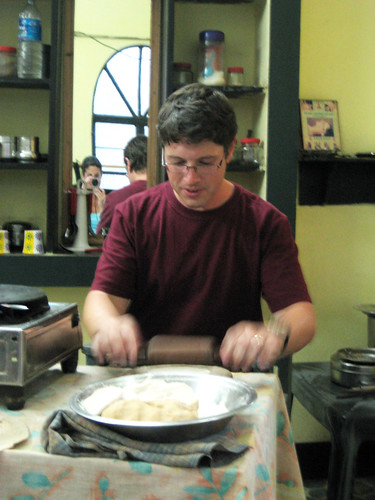Posted from Delhi, India
Last night, after spending the day walking around the city palace, but before we went to see Octopussy, Matt and I took a cooking class. Together. I mean, Matt and I cook together all the time. But this was totally different, given that usually when we cook together, I take on the role of the Alpha cook, screaming at him to get me that spoon, no THAT spoon!, and generally being bossy in my domain. Over the years that we've lived together, I've gotten progessively better at sharing the kitchen, but I am a LOOONG way from winning the "Cooperative Cook of the Year" award. So I thought that taking a cooking class together would be interesting, especially as my previous forays into the realm of Indian cooking have turned out surprisingly poor results. It's not surprising because I consider myself such a good cook, but surprising because I want, SO badly, to be able to make Indian food. I am happy to be the first to report that no Weyants were harmed in the process of making the delicious Indian meal we ate last night!
This post is named, not for a B-minus porn flick, but for the cooking class we took. It is also the name of the ubiquitous metal box found in every Indian kitchen. It's a magic box because it contains all of the spices necessary to make a basic curry. And last night, for the first time since I lived with Tejal all those years ago and watched her pull delicious meals out of about 3 ingredients, I finally understood its importance.
Generally speaking, most Indian dishes have very few ingredients. And the spices seem to be the most important part of any meal. As we learned last night, the contents of a spice box include brown cumin, fennel seeds, brown mustard seeds, turmeric powder, coriander seed powder, red chili powder, and fenugreek seeds. Those spices, together with the ever-present garam masala; salt; pepper; black cardamom; and a paste made of onion, garlic, and ginger, form the backbone of almost every single Indian dish you have come to know and love. And here was where I had my Halleluyah! moment. Whenever I have tried to make an Indian dish, my hopes were always dashed at the first taste. I've added enough red chili powder and plenty of cumin. I even went out and bought the expensive garam masala. But I never knew why, if I followed the recipe to a T, my daal never tasted like Tejal's daal, my curries always lacked...SOMETHING. Last night I found the answer in just five words: BROWN mustard seeds and BLACK cardamom! NO WAY! Way. Over here in India, mustard seeds are not pukey yellow. They are brown. And cardamom is both green and black. When I tell you that yes, there certainly IS a difference in flavor, it's like trying emphasize the difference between, say, an 18-year-old Single Malt Scotch and that stuff on the bottom shelf of your liquor store that says, "Whisky" on the label. It's THAT different.
We started off the meal with a glass of chai. Chai is ubiquitous in India, synonymous with a handshake in the US. When someone offers you chai, you drink it. And you drink it every day. Twice a day. THREE times a day. It is sweet and milky and has a nice lingering little spice. It's a warming beverage, but even in the heat of India, it can cool you down. It's amazing stuff. And here I will give a shoutout to Matt, who donned his apron as directed by our (slightly intimidating) teacher and was the first student in the hotseat, making this most-important beverage for our entire class. It was delicious.

After the chai, we made Khadai Paneer, which is basically paneer (an unfermented cheese), green peppers, and onions in a tomato-based curry. Next came Malai Kofta, which are these fried potato balls in a cream sauce, which, even though they sound heavy, are ridiculously light and delicious. The base of the kofta formed the foundation ingredients for our vegetable cutlets (a potato-vegetable snack that, dare I say it, rival latkes in their yumminess). Then came another cup of tea (of the kashmiri saffron variety) and biryani, which is a rice dish made with a bunch of spices and that ever-delicious basmati rice. Finally, we learned how to make chapati, which is the bread that's actually most often eaten in Indian households (sorry Jules, I too wish that everyone ate Naan all the time), and we each got to take a turn at rolling out and cooking this simple bread.
We ate our dinner as though we hadn't spent the past two hours snacking on the outcomes of our cooking forays, and at the end of the meal, our teacher surprised us with some gulab jamun. If you haven't had it, go, RIGHT THIS MINUTE, to the Indian section of your grocery stores and buy some gulab jamun. It's the sweetest most delicious thing you'll ever eat. I promise. And if you don't like it, which a lot of people don't, because they are crazy and think it's too sweet, that's okay, because I will visit you and eat your leftovers for you.
Now I'm not crazy enough to think that I know how to cook Indian foods after one night in an upstairs kitchen in Udaipur. But I will say that I feel significantly less intimidated by my plethora of Indian cookbooks. Which is lucky for those of you guys living in the Boston area, and particularly for those of you in the Boston area who like Indian food! But the best part is that when I make said Indian food, I might just let Matt help.




1 comment:
Seriously, brown mustard seeds and green AND black cardamom? I hope you stocked up enough for sharing with me....
Post a Comment